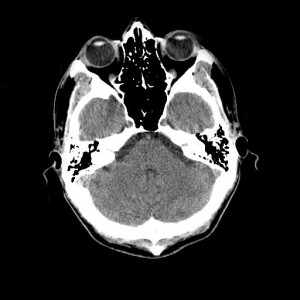
When does a trauma patient need a CT scan? Clinical rules could help doctors decide, and in the process help reduce a child's lifetime radiation exposure. (Image: Andrew Ciscel/Flickr)
The use of computed tomography (CT) scans has dramatically changed the practice of medicine in the past two decades. Patients with abdominal pain are no longer routinely admitted for serial abdominal exams to evaluate for appendicitis, because now we can just get the CT. Children with head trauma may need less hospital observation time in the emergency department (ED), because we can just get the CT.
But “just getting the CT” comes with costs, not just medical healthcare dollars spent but the costs associated with lethal malignancies in the future caused by the radiation used in the course of CTs.
Since the mid 1990s, the use of CT has more than doubled in the United States. At that time, doctors did not give much thought to the long-term and cumulative effects of ionizing radiation. Now, however, we know that children in particular have a heightened risk of CT-related cancers because of their immature tissues’ increased sensitivity to the effects of radiation, the longer relative span of time they have to manifest cancer, and the fact that pediatric radiation dosing is not used universally (meaning that during a scan some children are exposed to the same amount of radiation that would be used with an adult). And the relative risk of lethal malignancy increases with younger age, so that while a child under 10 has a 1 in 5,000 risk of developing a lethal tumor from a head CT, for a child under age 1 the risk is 1 in 1,000.
Obviously clinicians need to use CT in patient care—we just need to be cognizant of the potential risks and also need to use available tools like decision rules to guide us in deciding when best to use this important diagnostic test.
This is where the power of numbers is important. Children’s Hospital Boston is part of the Pediatric Emergency Care Applied Research Network (PECARN), which is the first research-focused national network of EDs funded by the federal Emergency Medical Services of Children (EMSC) program. The more than 20 EDs in the United States that take part in PECARN take care of more than 800,000 children annually. With a focus on improving the care of children, PECARN allows researchers to access the large numbers of children needed to study serious pediatric illnesses and injuries with low incidence rates, and provides a mechanism for translating study results into clinical practice.
Traumatic brain injury (TBI) is one important area in which PECARN has conducted and published research. From 2004-2006, PECARN enrolled 42,412 children under 18 to derive and validate age-specific clinical prediction rules that would help identify those children at very low risk of clinically important TBI after a blunt head trauma, and who may not need a CT as part of their evaluation. The rules for each age group are relative simple, with only seven elements for each rule, and intuitive, based on clinical knowledge. According to our statistical calculations, they are also 99.9 percent effective at identifying children with head trauma who do not require a CT scan. If the decision rule had been applied within PECARN’s TBI study population, 25 percent of children under age 2 and 20 percent of those two or older could have avoided CT scans (which could have reduced their acute cost of care two-fold).
PECARN recently completed a study of over 12,000 children under 18 to develop a clinical decision rule for evaluating intra-abdominal injury due to blunt abdominal trauma. The results of this study were presented at this past May’s Pediatric Academic Societies meeting in Denver and again at last weekend’s Society of Academic Emergency Medicine conference here in Boston. Similar to the TBI decision rule, this abdominal injury decision rule will be an important tool to help guide clinicians in the most appropriate use of CT scans in their efforts to care for children and adolescents with blunt abdominal trauma.
With these types of clinical decision rules, clinicians can hopefully begin to further standardize the evaluation and care of pediatric trauma patients. Avoiding the CT scans in those at a low risk for TBI and intra-abdominal injury will be an important part of reducing CT use in children and, consequently, their future risk of lethal malignancies.
This is just one illustration of the power of numbers helping guide the clinical care of many.
 Lois K. Lee, MD, MPH, is a board certified pediatric emergency medicine specialist with a clinical and research focus on pediatric trauma care and injury prevention. As a staff physician in the Emergency Department at Children’s Hospital Boston, she pursues her interest in pediatric trauma care and injury prevention through teaching, research, and advocacy. Lee is also the medical director of the Emergency Department Pediatric Injury Prevention Program (PIPP), and in this role promotes child passenger safety and home safety, and advocates for legislation for the primary seat belt bill in Massachusetts. She also promotes injury prevention at home with her 8-year-old son and 4-year-old daughter.
Lois K. Lee, MD, MPH, is a board certified pediatric emergency medicine specialist with a clinical and research focus on pediatric trauma care and injury prevention. As a staff physician in the Emergency Department at Children’s Hospital Boston, she pursues her interest in pediatric trauma care and injury prevention through teaching, research, and advocacy. Lee is also the medical director of the Emergency Department Pediatric Injury Prevention Program (PIPP), and in this role promotes child passenger safety and home safety, and advocates for legislation for the primary seat belt bill in Massachusetts. She also promotes injury prevention at home with her 8-year-old son and 4-year-old daughter.






